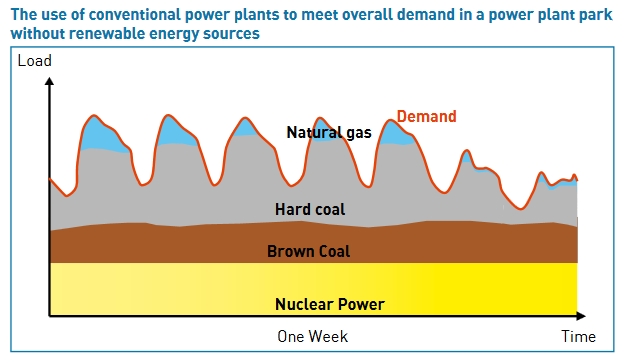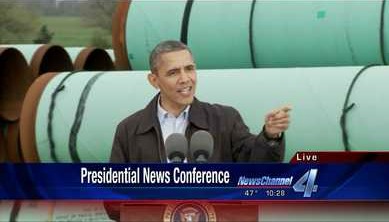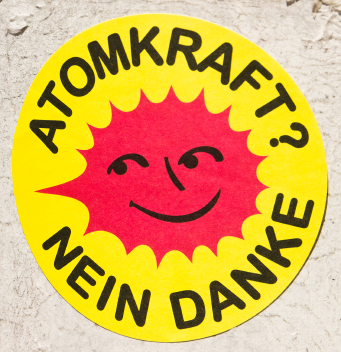 Germany is involved in a wildly ambitious overhaul of its power system. Its official targets are to hit 35 percent renewable power by 2020 and 80 percent by 2050. The Green Party advocates for 100 percent by 2030.
Germany is involved in a wildly ambitious overhaul of its power system. Its official targets are to hit 35 percent renewable power by 2020 and 80 percent by 2050. The Green Party advocates for 100 percent by 2030.
The most controversial aspect of this power overhaul is Germany’s post-Fukushima decision to completely phase out nuclear power by 2020, which caused the heads of Very Serious People to explode on multiple continents. To many, passing ambitious low-carbon energy goals and then axing a good chunk of your low-carbon energy seems irrational and self-defeating.
There are good-faith debates to be had about the speed of the phaseout and its proximate effects. It will probably lead to a temporary increase in carbon pollution. The hope is that it will accelerate the transition to renewables.
Putting those questions aside, though, I want to focus on one of the deeper debates about Germany’s nuclear gambit. Nuclear power’s proponents frequently point out that it is one of the only low-carbon sources that can serve as “baseload” (always on) power. Baseload power is needed, they say, because renewable sources like solar are intermittent (the sun isn’t always shining) and non-dispatchable (the sun can’t be turned on and off at will). You need large, steady, predictable power plants if you’re going to have all those flighty renewables involved.
Believe it or not, Germans have heard this argument before. They just think it’s wrong. They don’t think renewables and baseload are complimentary; they think they’re incompatible. In 2010, Federal Minister of the Environment Norbert Röttgen said:
It is economically nonsensical to pursue two strategies at the same time, for both a centralized and a decentralized energy supply system, since both strategies would involve enormous investment requirements. I am convinced that the investment in renewable energies is the economically more promising project. But we will have to make up our minds. We can’t go down both paths at the same time.
I find that non-energy nerds have a little trouble wrapping their heads around this, so let’s walk through it with the help of this report by the German Renewable Energies Agency.
Here’s how things work in your standard 20th century power setup:
Since consumption is fairly easy to forecast, production has been planned accordingly: permanently operating base load power plants cover that part of the demand that exists around the clock. When that basic consumption level is exceeded, medium load power plants are additionally used. Peak load power plants are used for unforeseeable fluctuations, such as faulty consumption forecasts or power plant outages, and for certain consumption peaks, such as the “lunch peak” at noon. Their generators provide full service within a few minutes, and are therefore flexibly usable.
So: baseload, medium load, and peak load, like a pyramid. This is what it looks like (when no renewables are involved):

That’s an idealized picture of the German set-up. Other countries use more coal or hydro and less nuclear, but the basic idea is the same.
Here’s what a high proportion of renewables would look like:

Again, this is an idealized representation. Two things to note: first, there can be big surges from day to day and week to week, depending on the weather. And second, if you have enough renewables, they completely takes over the space once occupied by baseload.
The conclusion is clear: what’s needed to complement renewables — to cover that “residual load” — is not baseload, not big, steady, always-on power plants. The residual load will fluctuate in ways that are only partially predictable. To cover it you need options that are flexible and responsive.
Nuclear power plants are not that. They are the opposite of that. In fact, they “have a technically mandated minimum down time of approx. 15 to 24 hours, and it takes up to 2 days to get them up and running again.” You can’t just flip them on and off as needed.
So what can fill that fluctuating gap? It will be a combination of demand-side measures (conservation, efficiency, and “peak shaving” through demand response), energy storage, a much smarter grid, and dispatchable power sources. These latter could include geothermal or biomass plants, but in the near term they will mostly be natural gas plants.
That’s what will mostly replace Germany’s lost nuclear power for the time being: natural gas.
Obviously, you can’t have a fully renewable power system if natural gas is playing a crucial role. So in the mid- to long-term, Germany will need a plan to phase out natural gas as well. In this informative analysis of Germany’s nuclear-to-renewables switch, Craig Morris notes one intriguing possibility. On particularly windy or sunny days, there will be surplus renewable energy and a need to store it for later. One way to store it is to convert it to synthetic natural gas. That not only solves the storage problem, but produces a zero-carbon liquid fuel to substitute for natural gas in all those dispatchable gas plants. That opens up the tantalizing possibility of a 100 percent green grid.
Regardless, to return to the main point: Germany’s vision of a renewable energy future involves rapidly phasing out baseload power. The Fraunhofer Institute for Wind Energy and Energy System Technology modeled the renewables projected for 2020 and found that the need for baseload power will fall by half.
Now, ideally Germany would phase out coal plants before nuclear plants — coal plants are far more deadly by any measure, and obviously more carbon-intensive. That’s going to be a problem, though:
The stock of newer hard and brown coal power plants — i.e., those brought on line or thoroughly refitted since 1990 — amounts to 15.6 GW. In addition, new hard and brown coal power plants with a total capacity of 11.4 GW are currently under construction. This already surpasses the forecast base load needed in 2020.
So there’s already a bunch of coal in the pipeline, and unlike with nuclear, the German government has no legal means of forcing those plants to shut down. If the nuclear phaseout is delayed, there will be more baseload than necessary — and thus less renewable energy than possible — on Germany’s grid.
Shutting down nukes may be a second-best solution, but it’s in service of a baseload-free, 100 percent renewable power system — a laudable goal that, in a sane world, far more countries would share.



